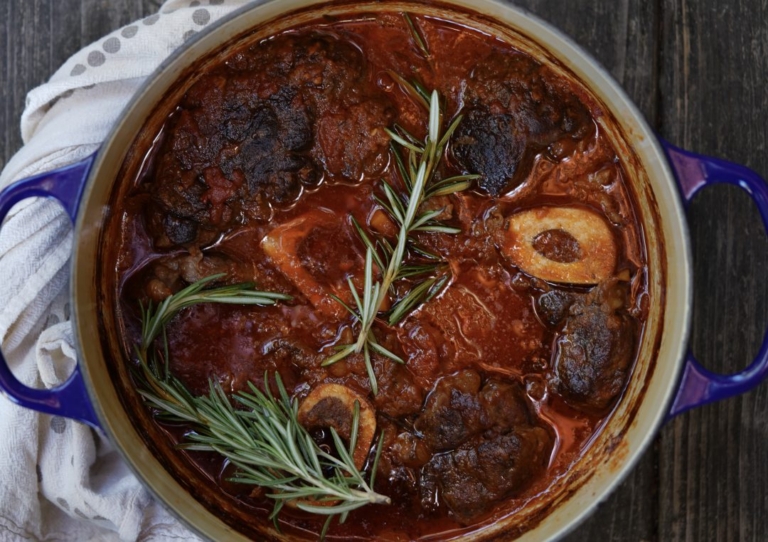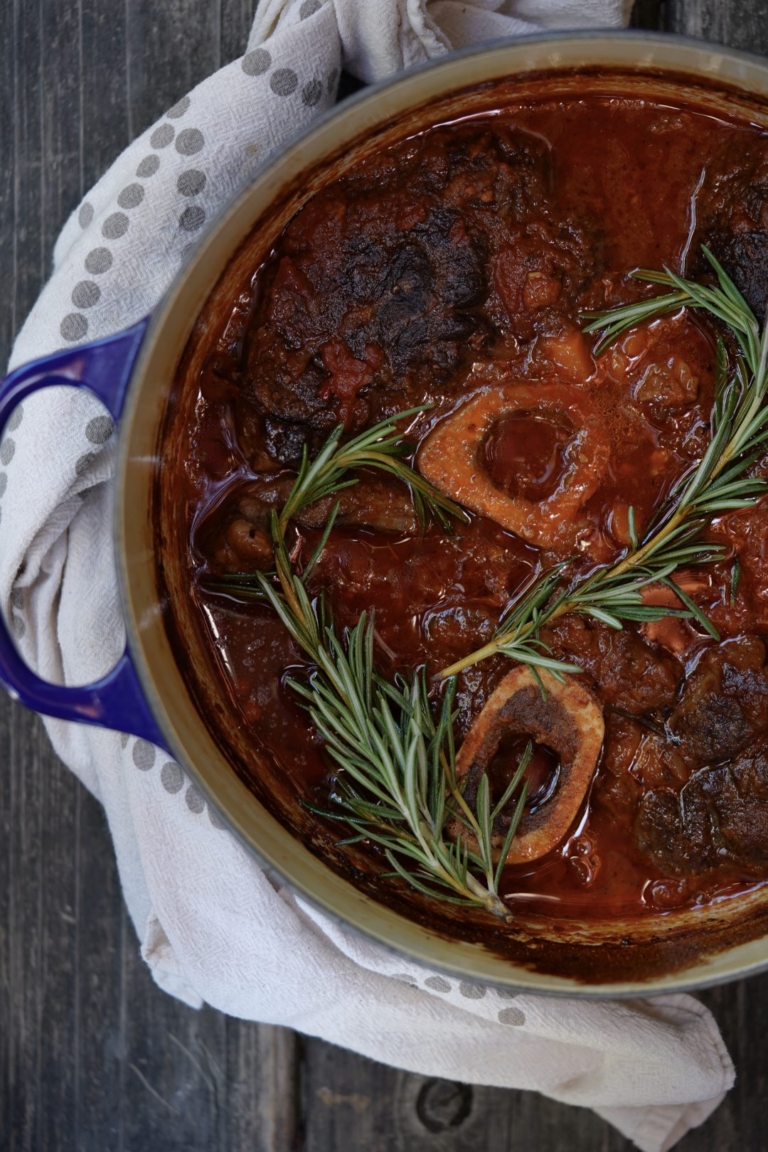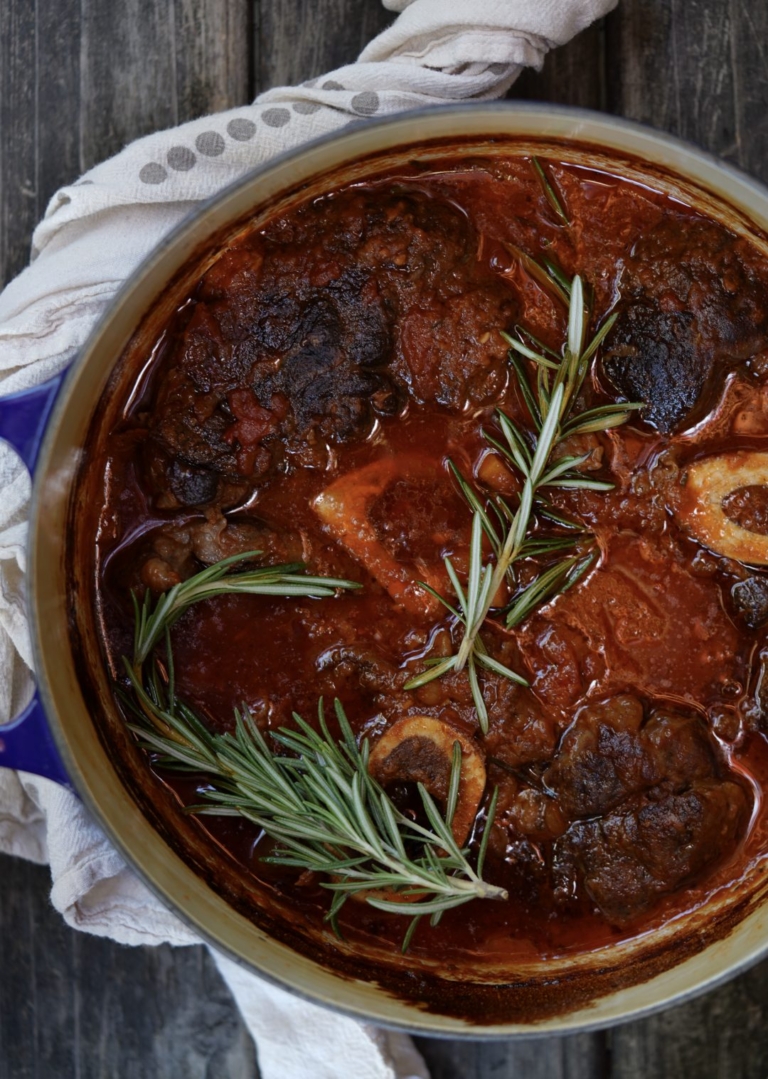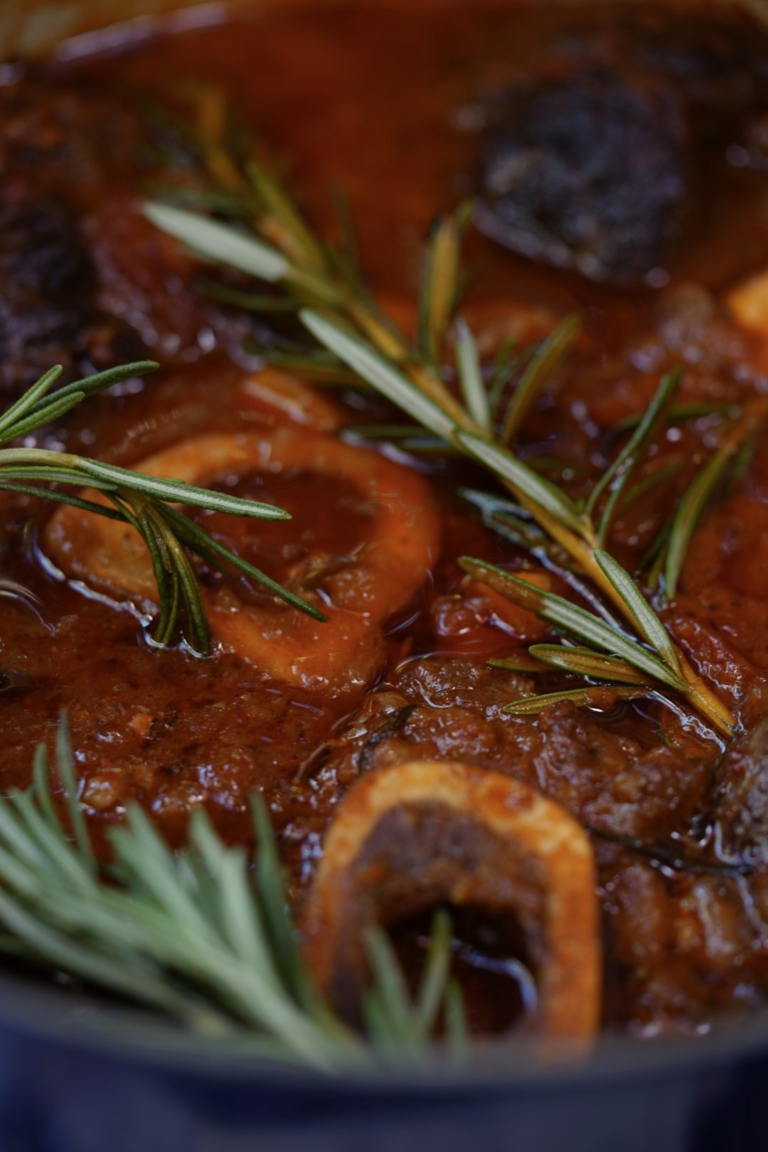Osso Buco

What Is Osso Buco?
Osso buco (also written osobuco, ossobucco, osso bucco), is perhaps the most famous Italian dish there is. The phrase itself, in Milan’s dialect, means “bone with a hole”, and is a fitting name for a dish that stars a succulent piece of meat—typically a shank—with a bone in the center. The rich bone marrow in the center gets released as it cooks and is what makes osso buco so incredible.
During the cooking process, all of the classic flavors of carrots, celery, and onions come together through the slow braising process, as the marrow from the center of the bone cooks down and creates a dreamy sauce that goes perfectly over a bed of creamy polenta or risotto alla Milanese. When cooked properly, the meat simply falls off the bone, and it feels as if it’s melting in your mouth. With rich complexity in every bite, it is a memorable dish and perhaps one of my favorites.
Where Did Osso Buco Originate From
This famous dish is believed to have emigrated from Italy with migrants, most likely from Lombardy. The classic recipe, at least in the 19th century and thereafter, has become well-known and is made all around Italy. Among the possible reasons for the popularity of osso buco is its low cost and the relative easiness of its preparation. Osso buco was considered an ideal dish for families, much like pot roast was for the Irish.
Veal Or Beef?
The traditional way to make osso buco is with veal shank served with the classic topping of gremolata, (or gremolada), a mixture of grated lemon peel, parsley, and garlic. However, I have modernized the recipe slightly and since I’m partial to beef shank, I use that in my osso buco instead and omit the gremolata completely. Some say beef shanks are just not as flavorful or tender as veal shanks, but I think that’s false and beef positively lightens this dish.
Prep Ahead And Forget
Osso buco is a very versatile and forgiving dish. Like other braised meats, it can be cooked ahead and stored for up to 2-3 days in the refrigerator. This dish also freezes very well. If prepping ahead for a holiday dinner, such as for New Year’s Eve, simply keep it in the pan ready to be reheated on top of the stove.
Osso Buco And Wine
- Wine for Cooking: Gavi di Gavi (often labeled as Cortese di Gavi) is Piedmont’s best-known white wine. Gavi is no longer inexpensive, however, you can do just as well with an Italian Chardonnay.
- Wine to Drink: When serving osso buco bold red from Piedmont is in order, a mature Barolo or Barbaresco, will have a bouquet to match the complexity of this classic Italian dish.
Like some of my favorite classic French dishes such as coq au vin and beef Wellington, osso buco too is timeless. This dish is an elegant one, worthy of holiday guests, yet simple enough to be enjoyed with your immediate family on a snowy winter day. Made with either beef or lamb, this is a dish all should learn how to master.
Osso Buco
Ingredients:
- 3 tablespoons Extra Virgin olive oil, divided
- 4 beef shanks, about 2-3 pounds, patted dry
- 1 teaspoon Kosher salt
- Freshly ground black pepper, to taste
- 2 stalks celery, small dice
- 2 carrots, small dice
- 1 medium yellow onion, small dice
- 4 Garlic cloves, finely chopped
- 2 tablespoons tomato paste
- One (28-ounce) can diced tomatoes
- 2 thyme sprigs
- 2 rosemary sprigs
- 1 bay leaf
- 3 cups bottle medium bodied red wine
- 1 cup good quality beef stock
- 2 tablespoons unsalted butter
- Fresh parsley, finely chopped, for garnish, optional
Directions:
- Heat oven to 350 degrees F. Gently pat the beef shanks dry with paper towel and season generously with salt and pepper. Set aside.
- Place a Dutch oven medium-high heat. Add 3 tablespoons olive oil and when hot, but not smoking, working in batches if needed, add the beef shanks and sear till nicely colored, about 3-4 minutes. Using tongs, gently turn the shanks and sear on the other side for an additional 3-4 minutes. Transfer the shanks to a plate and repeat this process until all the shanks have been seared.
- Reduce heat to medium-low and add the celery, carrots and onions to the pan. Cook until the onions are translucent, about 5 minutes. Add the garlic and cook for 1 minute longer. Add the tomatoes, tomato paste, thyme, rosemary and bay leaf stirring until fragrant, about 30 seconds.
- Return the heat to medium-high and add the wine, cook for about 1 minute, while stirring. Add the beef stock and bring to a simmer while stirring. Add the beef shanks back into the pan, cover and place in oven. Cook for 1 to 1 1/2 hours. Test for doneness with a fork. The meat should be very tender.
- Place the Dutch oven on the stovetop and swirl in the butter. Garnish with chopped parsley. Serve this classic dish with creamy polenta, mashed potatoes or buttered egg noodles.





